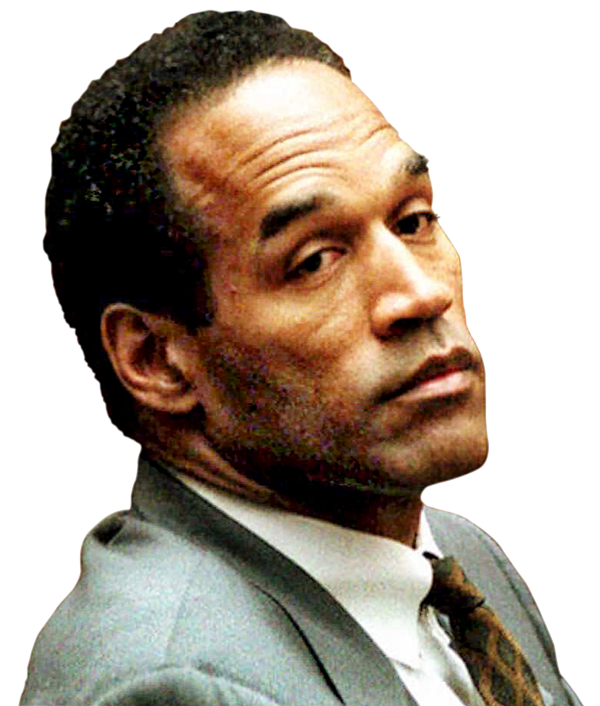
Just after midnight on June 13, 1994, Nicole Brown Simpson and Ronald Goldman were found brutally murdered outside Brown's Bundy Drive condo in Brentwood – an upscale community in west Los Angeles. O.J. Simpson and Nicole Brown Simpson had been divorced two years earlier. Evidence gathered at the scene led police to suspect that O.J. Simpson was the culprit. Nicole had suffered multiple stabs in the head and neck and also had defensive wounds on her hands. Her neck wound was gaping; she'd nearly been decapitated.
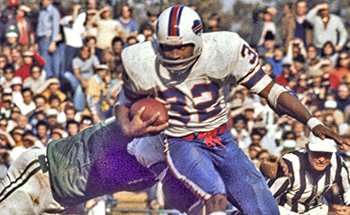
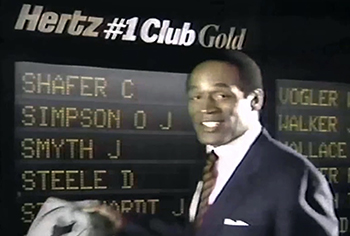
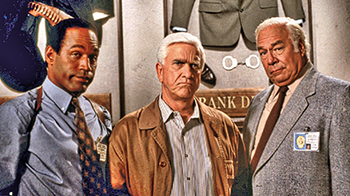
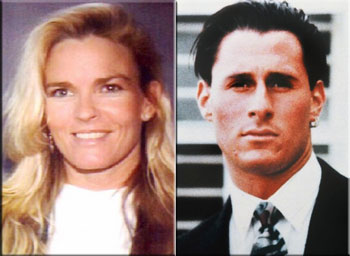
Four days later, over 1,000 reporters were waiting for Simpson to turn himself in at the police station, by pre-arrangement. He never showed up. By 2 pm, the LAPD issued an APB for the ex-football star. At 5 pm, Simpson's friend, defense lawyer Robert Kardashian, read a rambling letter from Simpson to the media and the public. "First everyone understand I had nothing to do with Nicole's murder," he wrote. "Don't feel sorry for me. I've had a great life." To many listeners it sounded like a suicide note.
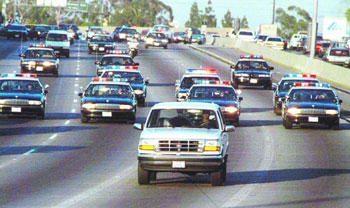
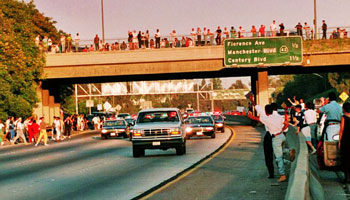
Later that evening, around 6:20 pm, a driver in Orange County saw Simpson riding in his white Bronco driven by his friend, Al Cowlings, and called police. The police were able to track cell phone calls made by Simpson in the vehicle. A police officer spotted the Bronco, heading north on the San Diego Freeway. Approaching with sirens blaring, the officer heard Cowlings yell at him that Simpson was in the back seat holding a gun to his own head. The officer backed away, but continued to follow the Bronco from a distance at 35 miles per hour. Up to 20 police cars would end up taking part in the chase -- as did a similar number of news helicopters. Radio and TV networks interrupted their regular broadcasts to cover the event, and it instantly became a bizarre, cultural phenomenon, playing out live on Los Angeles freeways to a rapt nation. Thousands of spectators packed overpasses along the route of the strange procession, waiting for a glimpse of the white Bronco and cheering when they saw it. The atmosphere was festive. Many people hung make-shift banners of support and encouragement for Simpson.
The chase ended at 8:00 pm at his Brentwood home. Police allowed Simpson to go inside for an hour; a spokesman said he talked to his mother and drank a glass of orange juice, which drew appreciative laughs from reporters. Attorney Robert Shapiro showed up a few minutes later, and Simpson finally surrendered to authorities. In the Bronco investigators found $8,000 in cash, a change of clothing, a loaded .357 Magnum, a passport, family pictures, and a fake goatee and mustache.
Simpson was arraigned and pleaded not guilty to both murders on June 20th. The presiding judge ordered that he be held without bail. The next day, a grand jury was impaneled to determine whether to indict him for the murders, but two days later it was dismissed because of excessive media coverage. Incriminating witness statements still emerged. A Brentwood resident, Jill Shively, testified that she saw Simpson speeding away from the area of Nicole's house on the night of the murders, and that the Bronco nearly collided with a Nissan at the intersection of Bundy and San Vicente Boulevard. Another witness, a knife salesman at Ross Cutlery named Jose Camacho, claimed he sold Simpson a 15-inch German-made knife similar to the murder weapon just three weeks before the murders.
After the preliminary hearing, the L.A. Superior Court moved the case from Santa Monica to the Criminal Courts Building in downtown Los Angeles, citing damage to the Santa Monica Courthouse from the Northridge earthquake and security concerns. The decision was probably fateful; a Los Angeles jury pool would be radically different than one from Santa Monica.
Veteran LAPD detective Tom Lange led the investigation. The prosecution did not pursue the death penalty, seeking instead a life sentence. TV exposure would eventually make many of the trial participants famous.
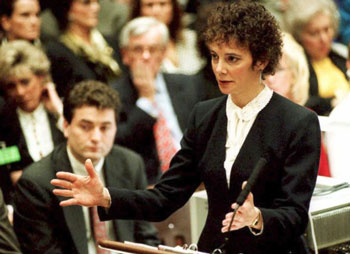
Prosecutor Marcia Clark, a 40-year-old Deputy District Attorney, won the lead prosecutor role. It would be her 21st murder trial in 13 years with the D.A.'s office. Deputy District Attorney Christopher Darden, an African-American prosecutor with wide murder trial experience, was Clark's co-counsel.
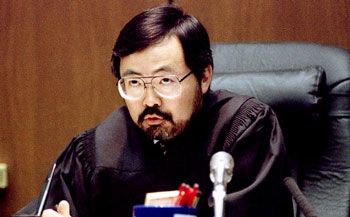
The trial began on January 24, 1995, covered by Court TV and other cable companies. Christopher Darden argued in his opening statement that Simpson had killed his ex-wife in a jealous rage. He played a 911 recording of a call Nicole Brown Simpson had made in January of 1989 in which she expressed fear that Simpson would physically harm her; in the background of the recording, Simpson could be heard yelling at her. Dozens of expert witnesses, on topics ranging from DNA fingerprinting to blood and shoe-print analysis, were presented by the prosecution. A mountain of evidence put Simpson squarely at the crime scene. In addition to this, he had a well-documented history of physically abusing Nicole. Her fears were well-founded.
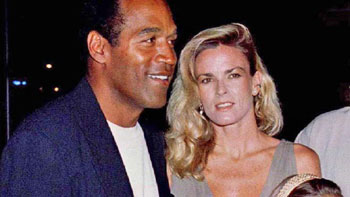
Soon after the trial began, viewers from the closed-circuit courtroom camera saw a pattern emerge: a ceaseless barrage of interruptions and objections from both the prosecution and the defense, as well as repeated breaks for "sidebar" conferences with the judge, out of earshot of the jury, which was located just out of camera range.
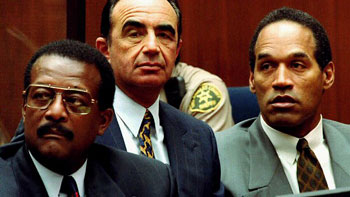
Simpson was able to hire a team of high-powered, high-profile lawyers that included F. Lee Bailey, Robert Shapiro, Alan Dershowitz, Robert Kardashian, Gerald Uelmen (dean of law at Santa Clara University), Carl E. Douglas and Johnnie Cochran. Dubbed the "Dream Team" by reporters, they were estimated to have cost Simpson between $3 and $6 million dollars. Two attorneys specializing in DNA evidence, Barry Scheck and Peter Neufeld, were brought in to discredit the prosecution's DNA evidence. They argued that Simpson was the victim of police fraud and egregiously sloppy internal procedures at the LAPD that rendered the DNA evidence worthless. LAPD detective Mark Fuhrman was accused of planting evidence. LAPD Criminalist Dennis Fung was the focus of especially severe scrutiny.
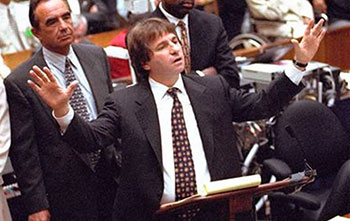
Though they lacked a murder weapon and witnesses, the prosecution believed it had a strong case. Buttressed by DNA evidence, they considered their chances for conviction excellent. The tale told by the physical evidence was damning: Simpson drove to Nicole Brown's house on the evening of June 12, intending to kill her. Nicole, after putting her two children to bed and getting ready for bed herself, either heard a noise outside or a knock on her front door. Answering it, she was grabbed by Simpson and before she could scream he attacked her with a knife. Ron Goldman arrived at the front gate of the townhouse with the assault still in progress and fell under immediate attack himself. His attacker stabbed him repeatedly in the neck and chest with one hand while holding him in an arm choke-hold. According to the prosecution, the killer, after finishing Goldman off, returned to the prone and weakened Nicole, pulled her head back by her hair, put his foot on her back, and slit her throat with the knife, severing her carotid artery. From there Simpson left a "trail of blood" from the condo to an adjacent alley; three drops of his blood were later found on the driveway by the gate to his house on Rockingham Drive.
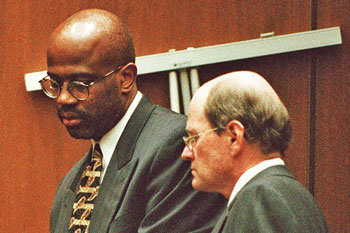
Simpson was last seen in public at 9:36 p.m. when he arrived at the front gate of his house with Brian "Kato" Kaelin, a bit-part actor and family friend who was given the use of a guest house on Simpson's property. He was not seen again until 10:54 p.m., when he exited his front door to a limousine hired to take him to Los Angeles International Airport (LAX) to fly to Chicago for a Hertz convention. There is no dispute between defense and prosecution as to the time of the murders: they took place sometime between 10:15 and 10:40 p.m. The prosecution contends that Simpson drove his white Bronco to and from the murder scene – a 5-minute trip. A witness near Bundy Drive saw a car similar to the Bronco speed away from the area at 10:35 p.m.
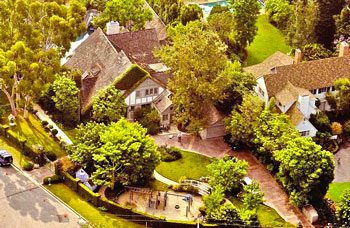
Limousine driver Allan Park testified that he arrived at Simpson's estate at 10:24 p.m. He didn't see Simpson's white Bronco as he drove past the Rockingham gate. According to Simpson, the Bronco had been parked there for several hours. At this time, Kato Kaelin was in the guest house, talking to a friend on the phone. Park first parked opposite the Ashford gate, then drove back to the Rockingham gate to see which driveway might have the best access for his limo. He decided the Rockingham entrance was too tight, and returned to the Ashford gate and buzzed the intercom at 10:40. There was no response. He got out of the limo and peered through the Ashford gate. He saw a dark house, except for a dim light coming from a second floor window. As he smoked a cigarette, Park made a series of calls from his cell phone in an attempt to get the phone number for Simpson's house.
Around 10:50, Kato Kaelin – still on the phone with his friend – heard three thumps on the outer wall of his guest house. He hung up the phone and went out to investigate but didn't want to chance the dark south pathway where the thumps had come from. He walked to the front of the property instead – and saw Allan Park's limousine.
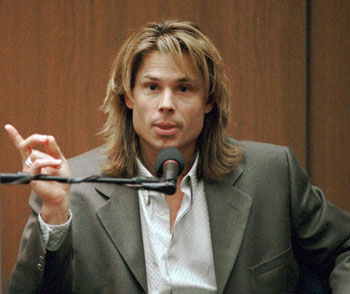
Park says that at the same time he saw Kaelin emerge from the back of the property to the front, he saw "a tall black man" of Simpson's height and build go in the front door of the house from the driveway. Lights went on, and Simpson finally answered Park's call, explaining that he'd overslept and would be out soon. Kaelin opened the front gate for Park and Park drove the limo onto the grounds. Simpson came out of his house through the front door shortly afterward. Kaelin and Park helped Simpson put his belongings into the limo's trunk. Both men would testify later that Simpson was agitated. Yet other witnesses – the ticket clerk at LAX who checked Simpson onto the plane, and a flight attendant – said Simpson looked and acted normally.
The details of Simpson's alibi changed over time. Johnnie Cochran claimed Simpson never left his house that night and that he was by himself, packing for his Chicago trip. As for the three thumps Kaelin heard, Cochran says Simpson went out back to hit a few golf balls into the children's sandbox, and it was flying golf balls that made the three loud thumps on the side of Kaelin's bungalow.
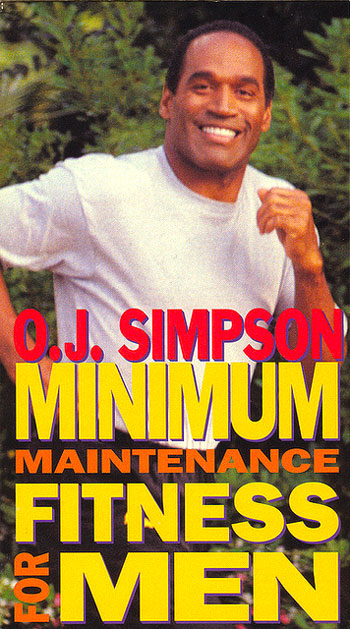
The Dream Team would later claim that Simpson was physically incapable of committing the murders, and that Ronald Goldman was a healthy young man who struggled fiercely against his killer. O.J. Simpson was, by contrast, a decrepit former football player with chronic arthritis, an old man with scars on his knees from old football injuries. But Marcia Clark entered into evidence an exercise video that Simpson had made just a few months before the murders, titled "O.J. Simpson Minimum Maintenance: Fitness For Men" which revealed that, all physical conditions and limitations aside, Simpson could hardly be called frail.
The prosecution then called Nicole's sister Denise to testify. On the witness stand she tearfully recalled many occasions when, during arguments, Simpson had picked up Nicole and hurled her against the wall, and physically thrown her out of their house.
The prosecution then turned to the evening of June 12, 1994. Karen Lee Crawford, the manager of the Mezzaluna restaurant where Nicole ate that evening, recounted on the stand that Mrs. Simpson's mother called the restaurant at 9:37 p.m. about her daughter's lost eyeglasses. Ms. Crawford found them in short order and put them in a white envelope. Waiter Ron Goldman then left the restaurant after his shift to drop them off at Nicole's house. The time was 9:50 p.m.
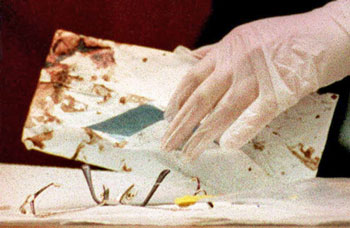
Next came the testimony of Pablo Fenives, a neighbor of Nicole's neighbor, who remembered hearing a "very distinctive barking" and the "plaintive wail" of a dog roughly 10 to 15 minutes after 10:00 p.m. while he was at home watching the 10 o'clock news. Another neighbor, Eva Stein, testified that she heard a very loud and persistent barking sound – also near 10:15 p.m. – which had awakened her and prevented her from going back to sleep.
Yet another neighbor, Steven Schwab, testified that he was walking his dog near Nicole's house at around 11:30 p.m., when he saw a wandering and agitated Akita dog, with bloody paws, trailing its leash. Taking a closer look at the dog, he found it uninjured. Schwab took the dog to a neighbor friend, Sukru Boztepe, who took the Akita into his home. The dog became more agitated. Around midnight, Boztepe took the dog for a walk. The dog tugged on its leash insistently and led him to Nicole's house, where he found Nicole Simpson's lifeless body. Boztepe flagged down a passing patrol car minutes later.
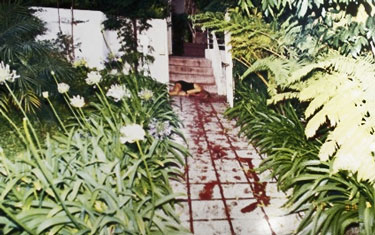
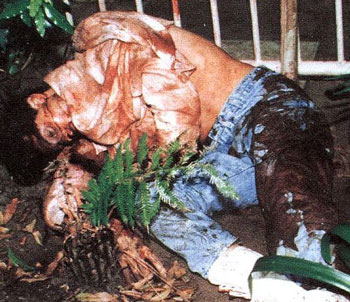
Robert Riske was the first police officer at the crime scene. He testified to finding a woman in a black dress, barefoot, lying face-down in a puddle of blood on the walkway leading to the front door of her house. He then noticed Goldman's body lying on its side next to a tree nearby, as well as the white envelope with Nicole's mother's glasses, Goldman's beeper, a black leather glove, and a dark blue knit ski cap on the ground near the bodies. The front door of Nicole's house was open. There were no signs of forced entry, and no evidence that anyone had entered the premises. Nothing inside was out of the ordinary.
A long motorcade traveled into Brentwood on Sunday, February 12, 1995. In it were the judge, jurors, prosecutors, and defense lawyers – all assembled for a two-hour inspection of the crime scene, followed by a three-hour foray of O.J. Simpson's Rockingham house.
According to the testimony of Detective Ron Phillips, when he called Simpson in Chicago to tell him of his ex-wife's murder, Simpson seemed shocked and upset, yet strangely unconcerned about how she had died. Detective Tom Lange testified that he believed Nicole was killed first because the bottoms of her bare feet were clean; she had been felled before there was any bloodletting. This reinforced the prosecution's contention that Simpson had set out to kill Nicole; only Goldman's inadvertent arrival had made him a target as well. In his cross-examination of Detective Lange, Cochran countered with two hypotheses of his own. First, one or more drug dealers had run into Nicole Simpson while looking for her friend and house guest, Faye Resnick, a known abuser of cocaine. Second, "an assassin, or assassins," had trailed Goldman to the house on South Bundy to kill him.
Samples from the bloody shoe prints leading away from the crime scene were tested for DNA matches. Initial test results failed to rule Simpson out as a suspect.
Dennis Fung, the police criminalist, said in his testimony that DNA evidence placed Simpson at Nicole Brown's townhouse at the time of the murders. But in a withering eight-day cross-examination by Barry Scheck, the validity of most of Fung's findings was relentlessly and effectively attacked.
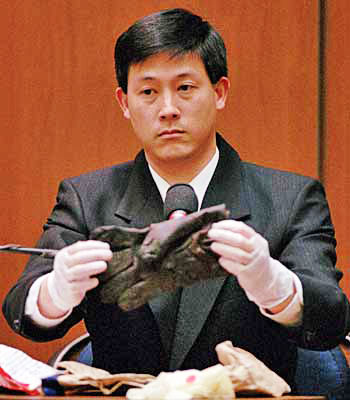
In Sheck's cross-examination of Fung and the other laboratory scientists, it was revealed that police scientist Andrea Mazzola, who collected blood samples from Simpson so that they could be compared with samples from the crime scene, was a trainee. She carried the vial with Simpson's blood in her lab coat pocket for almost a day before turning it over as an exhibit.
Scheck uncovered the fact that two errors had been found in the history of DNA testing at Cellmark, one of the LAPD's testing labs. They were found in quality control tests and had not reoccurred. One of the firms hired by Simpson's defense for DNA consulting had made the same error.
But Scheck turned what at first was thought to be a prosecution strength into a glaring weakness by mounting a torrent of accusations: bungling police technicians mishandling blood samples with such epic incompetence as to make reliable DNA results an impossibility. The prosecution argued – futilely – that they'd offered the DNA evidence to the defense for testing of its own; if the defense had problems with the prosecution's tests, they could do their own testing, with the same samples. The defense rejected that offer.
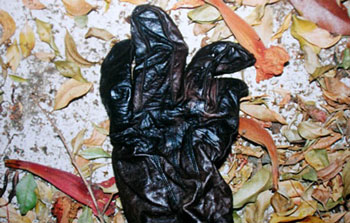
Then on May 16, Gary Sims, a California Department of Justice criminalist who had helped found the Department of Justice DNA lab, testified that the glove found at Simpson's house had tested positive for a match of Goldman's blood.
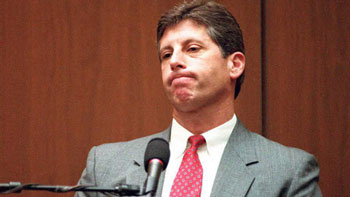
In March 1995, police investigator Mark Fuhrman testified that he had driven to Simpson's house in order to question him on the night of the murders. After getting no response buzzing the house intercom, he scaled one of the walls of the property and discovered blood stains on the driveway, as well as a black leather glove near Kaelin's bungalow. The glove had the blood of both murder victims on it, in addition to that of Simpson. In the face of a bellicose cross-examination by F. Lee Bailey, Fuhrman denied that he was racist or had used the word "nigger" to describe black people in the ten years leading up to his testimony. But a few months later, the defense obtained audio recordings in which Fuhrman used the "n" word repeatedly – 41 times, according to a defense count. The tape was the product of a 1986 interview between Fuhrman and an aspiring screenwriter, Laura McKinny, who was developing a screenplay about policemen. The Fuhrman tapes were a sensation – and foundational to the defense claim that his testimony was worthless.
In its closing statements, the prosecution attacked Fuhrman as a racist to the jury, but argued that it did not nullify the evidence of Simpson's guilt.
Investigators found one dark leather glove at the crime scene, its match turned up next to Kato Kaelin's guest house. Kaelin testified to hearing "thumps in the night" in the same area the night of the murder. Nicole Brown had purchased two pairs of this type of glove for Simpson. The prosecution argued that DNA evidence from Simpson, Brown and Goldman, was found on both gloves. The glove from Simpson's estate also contained a long strand of blonde hair similar to Brown's.
On June 15, 1995, attorney Johnnie Cochran jabbed at assistant prosecutor Christopher Darden – if the prosecution was so sure of itself, why not force their client to try on the glove in open court? Such a move would be highly risky for the prosecution, which had decided against it already. The glove had, according to prosecutors, been soaked in blood from Simpson, Brown and Goldman. It had also been frozen and unfrozen several times while in police evidentiary custody. There was no guarantee it would still fit Simpson's hand, even if it were truly his.
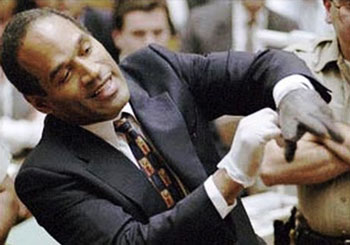
Eventually Darden gave in to Cochran's goading – with disastrous results for the prosecution. The glove indeed seemed too tight for Simpson to put on easily, particularly over the gloves he wore underneath. This was born the famous line Cochran used in his closing arguments: "If it doesn't fit, you must acquit."
Darden appealed to Judge Ito. Simpson had arthritis. He'd stopped taking his anti-inflammatory meds, so his joints were swollen and his hands were inflamed. The prosecution also believed the glove had shrunk from being soaked in blood and later testing. The prosecution presented a photo to the jury of Simpson wearing the same type of glove as those found at the crime scene.
Prosecutors said the presence of O.J. Simpson's blood at the scene of the crime resulted from blood dripping from cuts on the middle finger of his left hand. Police had taken note of his wounds when they first interviewed him and concluded they were incurred in the fatal attack on Ron Goldman.
The defense pushed back: none of the gloves had any cuts on them. Neither prosecution nor defense witnesses testified to seeing any cuts or wounds on Simpson's hands after the murders. The defense further alleged that Fuhrman could have planted the glove at Simpson's house after removing it from the crime scene. The prosecution denied this; by the time Fuhrman arrived Simpson's home after leaving Nicole Brown's condo, the crime scene had been combed through by investigators for nearly two hours. None had noticed a second glove at the scene.
In closing arguments, Darden mocked the notion that police officers wanted to frame Simpson. Why, if the LAPD had it in for Simpson, had they gone to his house eight times on domestic violence calls and never arrested him? Why did they wait five days to arrest him for the 1994 murders? The answer was simple. The cops had no beef with O.J. They had simply gone where the evidence took them.
Johnny Cochran fulminated against Fuhrman in the defense summation. He compared Fuhrman – now shown to have slurred African-Americans as "niggers" and to have boasted of beating them while carrying out his police duties – to Adolf Hitler. Cochran condemned Fuhrman as "a genocidal racist, a perjurer, America's worst nightmare and the personification of evil." Fuhrman would later plead Nolo contendere to felony charges of perjury, arising in connection with his testimony at Simpson's trial.
Public fears were rife that race riots would break out in Los Angeles and the rest of the country if Simpson was found guilty. After the 1992 riots that followed the acquittal of four police officers for beating black motorist Rodney King three years earlier, such fears were not unfounded. L.A. police were put on 12-hour shifts. A line of over 100 officers on horseback encircled the L.A. county courthouse on the day of the verdict.
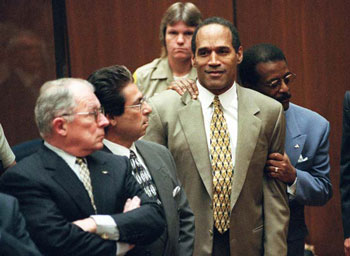
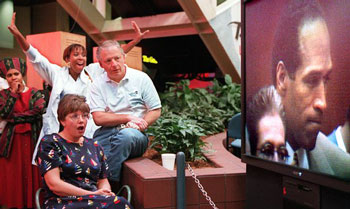
At 10 a.m. on October 3, 1995, the jury returned its verdict. O.J. Simpson was found Not Guilty. The only testimony reviewed by the jury, curiously, was that of limo driver Alan Park, who had stated that he did not see Simpson's Bronco outside the Rockingham estate after the murders. The Jury had actually reached its verdict by 3 p.m. the previous day, after just four hours of deliberation.